As there aren’t many Mexican restaurants around here and those that are there are probably not very authentic, I don’t eat a lot of Mexican (or Tex-Mex) food that I don’t prepare myself. And so I had never before seen or tasted tamales. Ever since I saw the recipe on Richard’s blog, I wanted to make them. If you want to know more about the history of tamales, go visit Richard’s wonderful blog post for a very entertaining story.
Tamales are a bit like baozi or bapao, filled buns that are steamed from China/Indonesia. For tamales the ‘bun’ is made from masa, instant masa corn flour mixed with stock (or water) and lard (pork fat) and wrapped in a corn husk, banana leaf, avocado leaf, or paper before it is steamed. Maseca is the most common brand of the instant masa corn flour you need. The corn flour needs to be nixtamalized, a process whereby the corn is dried and then treated by soaking and cooking in a diluted solution of slaked lime or wood ash. This is an ancient process and I think it is pretty impressive it was discovered thousands of years ago that nixtamalizing enhances not only the flavor but also the nutritional value of corn.
There are many types of fillings; in this case I stayed close to Richard’s recipe and used pork. Richard, and many other sources online, state that making tamales is a lot of work. In terms of effort it is comparable to making ravioli from scratch, something I do on a regular basis, so I thought it is very doable. It is still a good idea to have a tamalada, a party where you make and then eat the tamales together with friends.
The result was absolutely delicious, so it sure is worth to put in the effort! I made some minor changes, as I cooked the pork sous-vide instead of in a slowcooker (no surprises there), used pork stock to make the masa instead of chicken stock, toasted the chiles, and used a roux of masa and lard to thicken the sauce instead of bread. But otherwise I used Richard’s recipe and instructions. I wish he could have seen this. If you don’t have sous-vide equipment, visit Richard’s blog for instructions to cook the meat in a slowcooker (which could easily be adapted to cooking in the oven or on the stovetop instead).
Ingredients
Makes about 16 tamales
banana leaves (or corn husks, avocado leaves, or paper)
For the masa
350 grams (3 1/4 cups) maseca
840 ml (3 1/2 cups) pork stock
1/2 tsp salt
1 tsp baking powder
150 grams (3/4 cup) lard, at room temperature
For the pork
1 kg (2.2 lbs) pork shoulder
1 1/2 tsp celery salt
1/2 tsp garlic powder
1 1/2 tsp ground cumin
1 1/2 tsp dried oregano
1/2 tsp ground black pepper
For the sauce
3 New Mexico chiles
2 Guajillo chiles
1 ui, chopped
2 cloves garlic, chopped
juices from the sous-vide bag (about 250 ml, 1 cup)
1/2 Tbsp dried oregano
1/2 tsp cumin
1 Tbsp lard
2 Tbsp maseca
salt, to taste
Instructions
Cut a kilo of pork shoulder into thick slices (so it is easier for the spices to penetrate the meat).
In a small bowl prepare the dry rub by mixing 1 1/2 tsp celery salt, 1/2 tsp garlic powder, 1 1/2 tsp ground cumin, 1 1/2 tsp dried oregano, 1/2 tsp ground black pepper.
Rub the spice mixture into the meat on all sides.
Vacuum seal…
…and cook sous-vide for 24 hours at 74C/165F.
Take the bags out of the sous-vide after 24 hours. Reserve the juices from the bag(s), you should have about 250 ml (1 cup)…

…and chop the meat (or use two forks) to get the texture of pulled pork.
Carefully toast 3 New Mexico chiles and 2 Guajillo chiles in a medium hot pan for about 5-10 seconds per side.
In a blender combine the toasted chiles with a chopped onion and a chopped garlic clove, 1/2 tablespoon dried oregano and 1/2 teaspoon cumin.
Add the reserved juices from the sous-vide bag, then process…
…until the sauce is completely smooth.
Melt a tablespoon of lard in a saucepan.
Add 2 tablespoons of maseca.
Stir over low heat until it becomes golden, about 1 minute.
Add the sauce from the blender…
…and stir over medium heat until the sauce comes to a boil and thickens, then turn off the heat.

Add the sauce to the meat in a large bowl…

…and stir to mix. Taste and adjust the seasoning. The hardest part when preparing this recipe is to stop yourself from eating the entire bowl! I’m serious, we had a tamalada and I had to hide the bowl to keep it safe!
To make the masa, put 150 grams of lard, which must be at room temperature as otherwise it is too firm, with a teaspoon of cold water in the bowl of a stand mixer.
Whisk this until the lard is fluffy.
Then add 840 ml of pork stock, 300 grams of maseca, 1/2 teaspoon salt, and 1 teaspoon baking powder.
Process with a balloon whisk until the mixture is homogenous.
Then add the remaining 50 grams of maseca.
Continue to process until it has been incorporated.

Drop a teaspoon of the masa in cold water. If it sinks, the masa is not fluffy enough and you need to process it longer…
…until a teaspoon of masa floats in cold water.
The masa is now ready to be used.

Wash and dry the banana leaves before using them. Corn husks have to be soaked before they can be used, but banana leaves need to be toasted briefly in a medium hot frying pan. This will make them more flexible. Only about 10 seconds per side is needed. If they are not toasted or if they are toasted for too long, they will be brittle and will break when you try to fold them.
The banana leaves I used were round, so I tore off a small piece from one side. Spread out about 2 tablespoons of masa on a banana leaf, leaving an edge of about 5 cm (2 inches) on one side.
Arrange about 2 tablespoons of filling on top.
Now close the first ‘flap’…
…then the second…
…and finally fold over the edge that didn’t have any masa. You have now created an envelope that is open on one side.
Stack the tamales in a steaming basket with the open side up.
Keep going until you have used up all the filling and/or masa.
Put the steaming basket over a pot with about 5 cm (2 inches) of simmering water…

Cover the tamales with a banana leaf…
…and then cover the steaming basket with its lid. Steam the tamales for 60-90 minutes.
The tamales are done when the masa is firm and comes loose easily from the banana leaf.
You do not eat the banana leaf…
…so unwrap the tamale before eating.
Wine pairing
Although I suppose most tamales are enjoyed with margaritas or beer, it was very nice with this unoaked Mencía from Valdeorras in North-Western Spain. The wine is spicy and low in tannins, which works well with the pork and the sauce. A Zweigelt from Austria (a similar wine) would also work.
Flashback
These ‘water gnocchi’, made from a dough much like that of éclairs, are filled with a small piece of pancetta and served with a tomato sauce. The ‘surprise’ of the tasty pancetta inside of the pillowy gnocchi is wonderful, and it works very well with the tomato sauce. Although it is a bit of work to put a piece of pancetta into each gnocco, it is still a relatively quick fresh pasta dish.






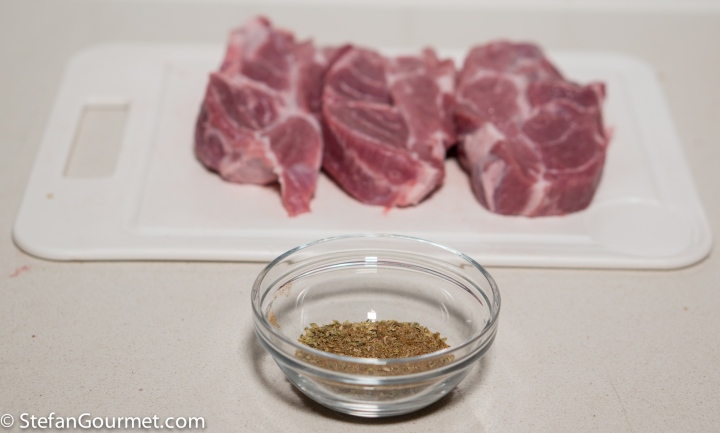









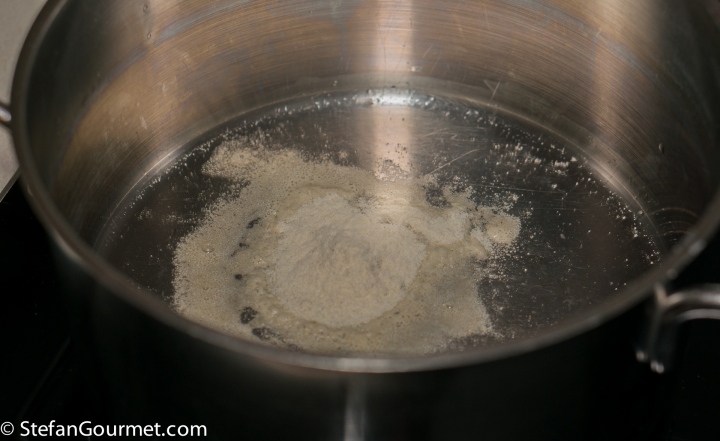








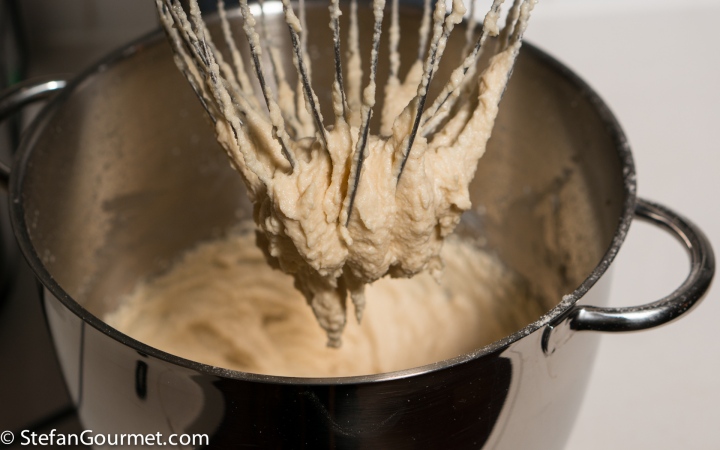

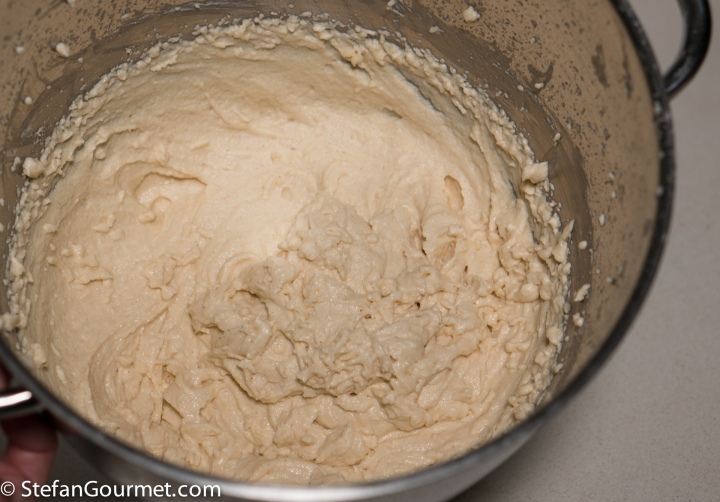










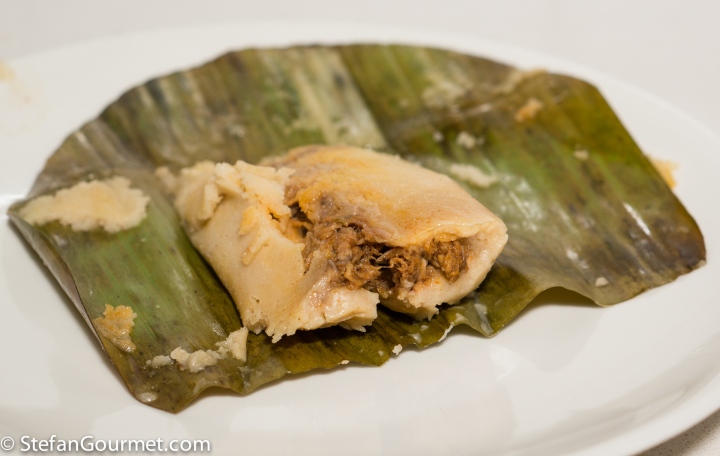



I have always wanted to make my own tamales! I’ll have to find a friend or friends to have a tamalada to do that, I’d probably be overwhelmed trying to do this myself. I am sure Richard would have been very pleased with your results. They look just delicious!
LikeLiked by 1 person
Thanks, Kathryn. It was nice to do the toasting and wrapping with some help, and I always like to have company while I’m cooking.
LikeLiked by 1 person
Bravo! Those tamales look wonderful. Richard would be tickled that you used his recipe. I love the addition of the roux. I will need to try that.
Love, Elia
LikeLiked by 1 person
Ma’am . . . . I am SO happy to read your comment here. Methinks there are many of us who dearly remember Richard and all of us reading who learnt something fro his gentle ‘coaching’ . . . . sincerely hope you are well . . .
LikeLiked by 1 person
Thank you Elia, this means a lot and I am so glad I finally tried Richard’s recipe!
LikeLike
I love your step by step tutorials Stefan. Never made tamales before. The masa batter process is intriguing.
LikeLiked by 1 person
I have made tamales using directions from the website of a food company. They were heavy. This is amazing to observe! This is very interesting. I will be using this recipe soon. My goal is to use dried chili peppers often. Your gnocchi are genius. Visiting your blog is a pleasure.
LikeLiked by 1 person
Thank you so much. I think Richard’s advice to use baking powder and to keep whipping until the batter floats are what make these so light (well, relatively speaking).
LikeLiked by 1 person
I already collected some of the ingredients. I believe that they will be much lighter relative to the tamales that I originally made. But not lighter than an atom! I have to travel to have corn husks. I do not believe I will find banana leaves. I watched a video from Mexico where people used leaves from trees outside their home to make tamales. This is exciting. These tamales are going to be a success!
LikeLiked by 1 person
Would love to hear how they turn out. You could also use paper.
LikeLike
These tamales are the best. Having this recipe is a privilege. I put my experience on my blog. Your blog is very exciting. Thank you!
LikeLiked by 1 person
Yummyy
LikeLiked by 1 person
Huge ignorance as to matters past the name! Quite fascinating but spoken in a ‘strange’ language to me: well, we just have to try !!! Prof Boer: am a fast learner 🙂 !! Remember : I kind’of live in Asia . . . 🙂 !!
LikeLiked by 1 person
From a self-professed tamale snob, these look spot on. I think it’s funny that you mention to not eat the banana leaves. You wouldn’t believe how many first-time tamale eaters try chewing through the corn husks. Again, outstanding!
LikeLiked by 2 people
Thanks so much, Adam, this means a lot coming from you.
LikeLike
As one who got great pleasure in making Tex-Mex foods for my Dutch friends during my visits to Amsterdam, i applaud your willingness to tackle foods you’d never seen, much less eaten. The only southwestern Americans who make tamales are Mexican grandmothers. The rest of us just buy them from Mexican markets or street vendors. I do have to say that any Mexican or southwestern American would be horrified at being offered a tamale cooked in a bright green banana leaf instead of a corn husk because, although it wouldn’t harm the taste, it would look as wrong as mashed potatoes dyed green. Also, if you can get “masa harina”, it would probably be cheaper than the packaged Maseca brand of it. The word “instant” on the Maseca package is just marketing, which you can see if you look at the ingredients.
LikeLiked by 1 person
It was easier for me to get the banana leaves than the corn husks. I chose the photo of the tamales before steaming because I liked the bright green color. Funny that you mention Mexican grandmothers — Italians keep telling me that it’s only the grandmothers that still make ravioli from scratch, too.
LikeLiked by 1 person
Ever since I lived in Mexico for the first time (I lived there twice), tamales are one of my favorite Mexican foods. Easy and fast to make and as flavorful as one wants them to be :-). My most loved condiment for tamales is salsa verde, other than that, anything goes, depending on the mood I am in 🙂
LikeLiked by 1 person
I love Mexican food. Used to be spoilt when I lived in Los Angeles . I make them as we do in Los Angeles with corn husks not banana leaves.
LikeLiked by 1 person
It was easier for me to get the banana leaves than the corn husks. I don’t think it affects the flavor noticeably.
LikeLiked by 1 person
Great recipe Stefan. Funny to see us both doing Tex-Mex in the same week. I was thinking of Richard when doing mine, too.
LikeLiked by 1 person
Bello ma … credo che continuerò ad andare al ristorante messicano
LikeLiked by 1 person